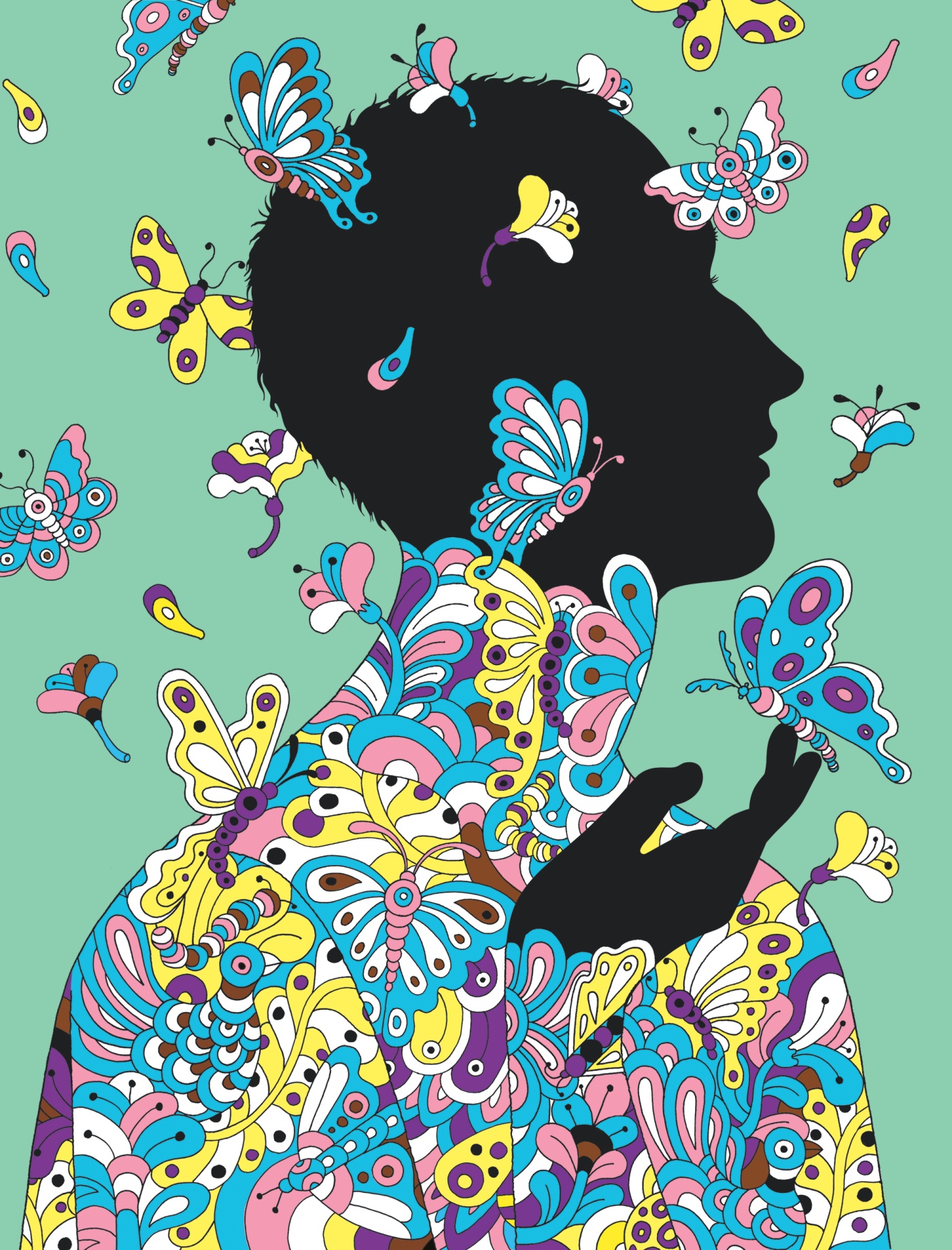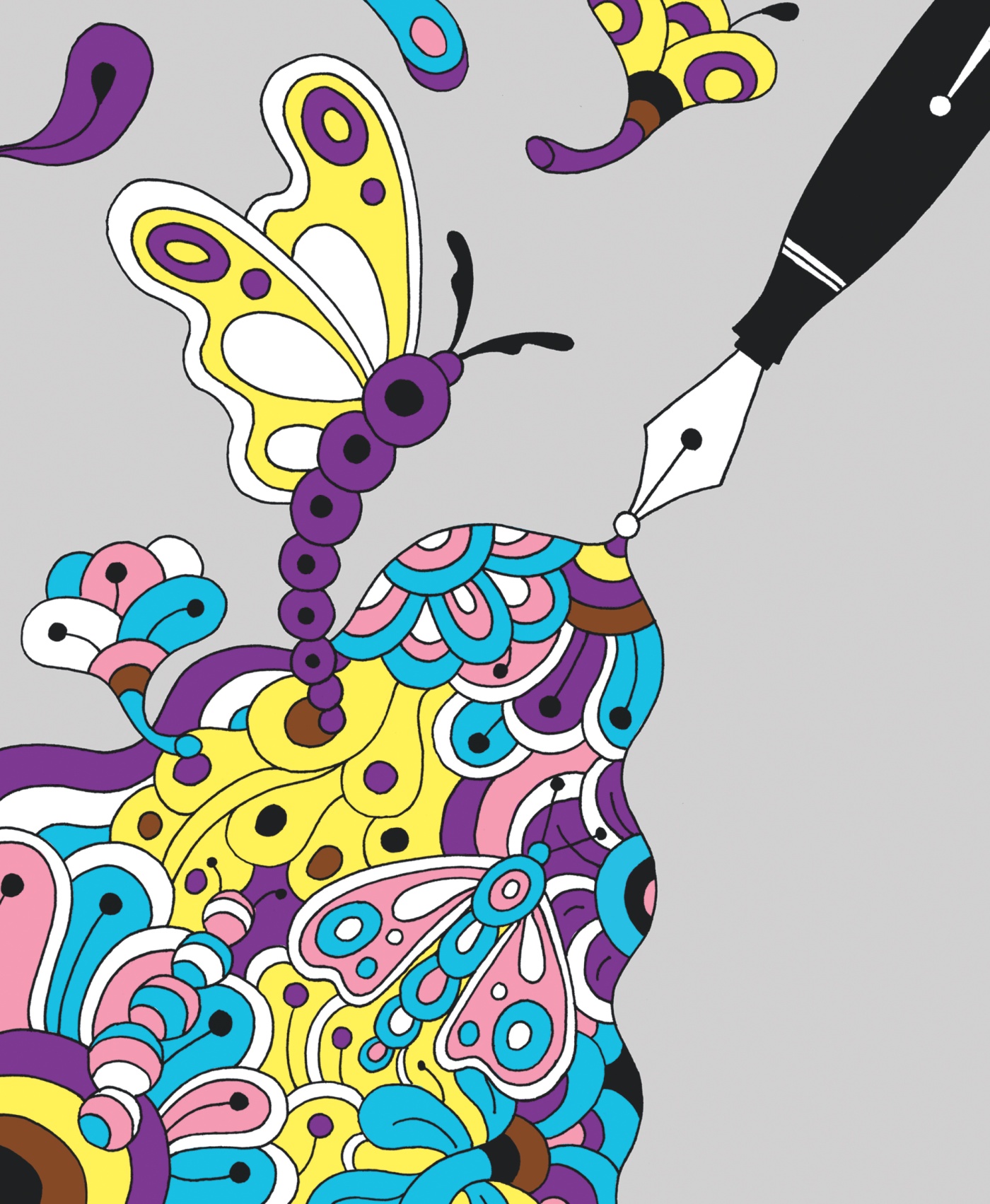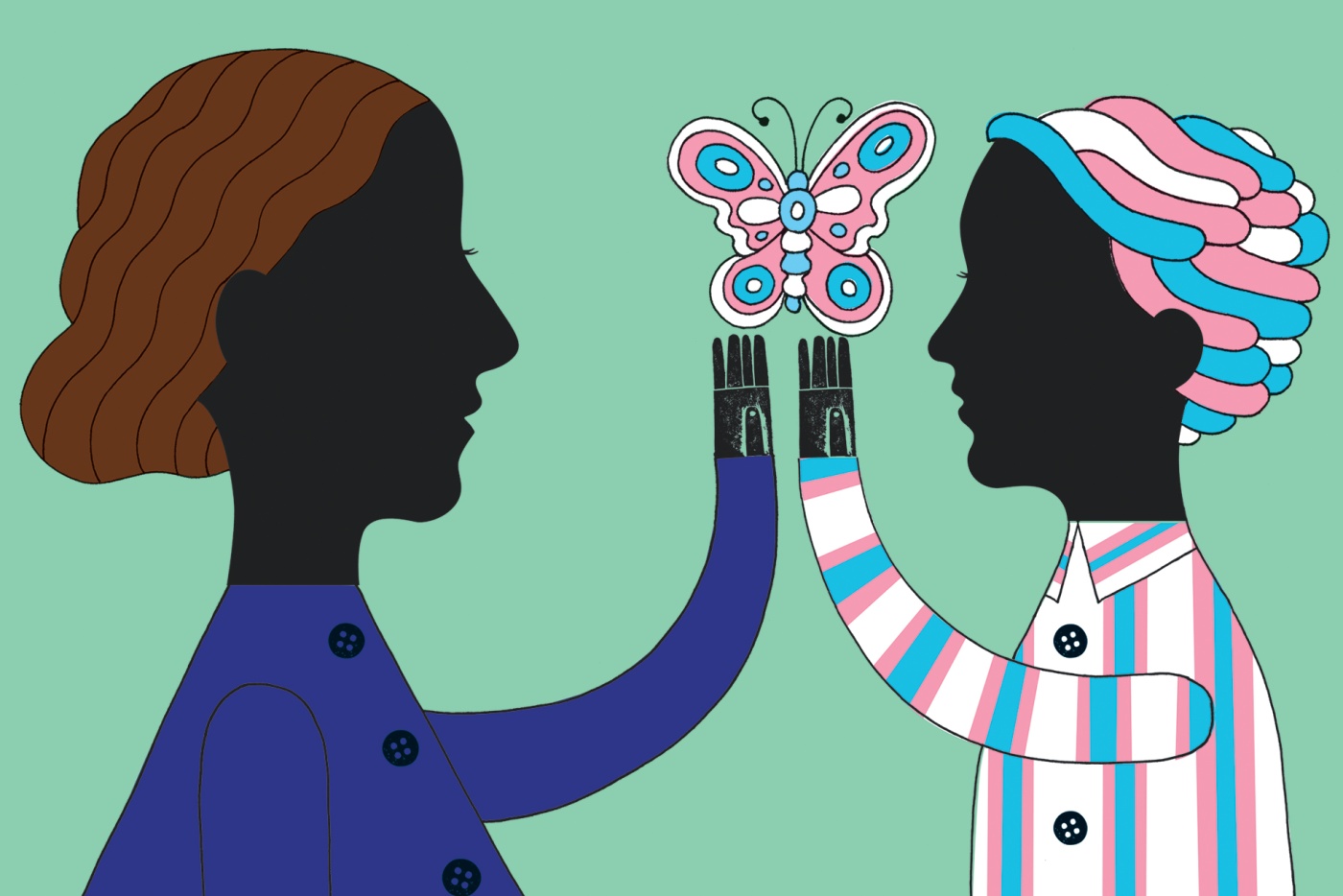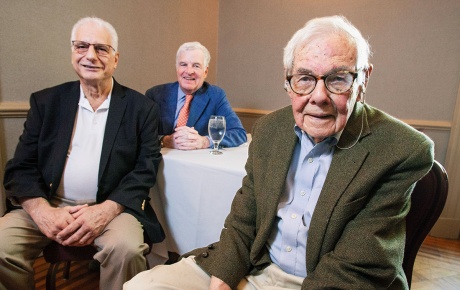The Gender Q
Some see “gender fluidity” as the latest wrongheaded trend in youth culture. Others argue the gender binary was a flawed system from the start. In a time when gender identity and expression are more fiercely politicized than ever, Gen Z is forcing a reckoning over traditional ideas of male and female—and whether they’re as simple as they seem.

What happens if someone is a man but they turn into a woman? the middle school girl asked health educator Connie Collins ’23.5.
Collins won a research grant for her thesis in gender studies and three of her closest friends transitioned at Brown: two identify as trans, one as nonbinary. But for Collins, there was no crash course in gender quite like her current job: teaching sex ed to middle schoolers in Brooklyn, N.Y.
The program she works with has a narrow focus, so when students ask questions, she’s on her own. To answer the girl’s question about trans women, Collins used the term “assigned male at birth,” for starters. And “I try to explain to them it’s not ‘turning into,’” Collins says.
Both Collins and her students are members of Gen Z, a generation that has brought the topic of gender identity into the mainstream and, with it, a “shaking off,” as a 2023 BBC article put it, of the neat gender binary that categorizes all human beings as woman or man, she or he. While some transition—culturally, medically, surgically—from one side of the binary to the other, many more occupy a space outside it, arguing that the two categories come with a litany of social expectations about how women and men are supposed to talk, dress, and behave—expectations that don’t at all match how they want to live in the world.
“ I like femininity a lot. I love makeup. I love dresses. I prefer to wear skirts over pants,” says Jules Griswold ’25, “ but I always also had masculine interests.” Griswold started identifying as nonbinary—neither man nor woman—four years ago. They realized “ there is a way to find a gender expression that works for you outside of the strict expectations that society puts out in terms of being masculine or feminine.”
“The sex/gender divide is a way people thought up to try and think about the world, but the world is actually much more complicated than that.”
Griswold is not alone. There has been a thousandfold increase in Americans who identify as trans or nonbinary, from Boomers to Gen Z. About 5 percent of American adults under 30 identify as trans or nonbinary, according to a 2022 Pew Research Center study—compared to 0.3 percent of those 50 and older. Half of the under-30 group said they know someone trans or nonbinary and half of Gen-Zers believe the gender binary is outdated. Brown reflects this generational shift—in a spring 2023 Brown Daily Herald poll of more than 1,000 first-year students, 3.1 percent identified as “nonbinary” and an additional 1.8 percent as “genderqueer.”
The American public isn’t sold: Last June, 51 percent of those surveyed told Gallup they think it’s morally wrong to change your gender—though they didn’t want to legislate against it, with six in ten saying that they opposed banning gender-affirming care for minors. Meanwhile, a 2023 survey by the Public Religion Research Institute found that about two-thirds of Americans (65%) believe there are only two genders, with half feeling “strongly” about that.

Those numbers change dramatically when you look at subgroups, however, with a majority of college-educated people and an overwhelming majority of liberals saying they’re supportive of trans people and of the concept of gender fluidity—especially if they know someone trans or nonbinary. In the academic and medical worlds and in Brown’s administrative policies, acceptance of gender diversity is the norm. And that’s even more true of the generation highlighted in this issue of the BAM.
“Kids are no longer just about pink and blue, and they’re telling us the world is a much more colorful rainbow,” said gender specialist Michelle Forcier, professor of pediatrics and assistant dean of medicine at the Warren Alpert Medical School, in a 2023 Brown lecture series on “Trans Youth Now.”
What are the reasons behind this shift?
Why Gen Z?
What’s changed, says Professor Denise Davis, director of Brown’s graduate certificate program in gender and sexuality studies, isn’t the number of people who don’t fit the binary, but the visibility of people who have existed in our society all along. Decades before Caitlyn Jenner, America’s first transgender star was World War II GI turned actress Christine Jorgensen, who transitioned in 1950. And in a 2019 talk on her book Transgender History: the Roots of Today’s Revolution, historian Susan Stryker notes that trans history in America dates back to well before our nation’s founding. In 1537, she says, Spanish explorer Álvar Núñez Cabeza de Vaca wrote about Indigenous Americans who were “men,” as he put it, but “they go about covered up like women and do the work of women.”
Still, why the exponential increase in visibility as Gen Z comes of age? Stryker cites the work of two Brown alums as having had a major impact: the mid-’90s play Hidden: A Gender and book Gender Outlaw by Kate Bornstein ’69 and the 1999 film about a trans man Boys Don’t Cry, produced by Christine Vachon ’83, for which Hilary Swank won a best-actress Oscar.
More broadly, Stryker points to changes in the early ’90s that set the stage for more trans and nonbinary visibility: the necessary inclusion of trans people in HIV education; the rise of trans activist groups; the internet allowing marginalized people to connect and organize. By 2014, the cover of Time magazine asked, “Is this the Transgender Tipping Point?”
Now Gen Z, powered by social media, has mainstreamed the term nonbinary, appealing to young people who may not have classic gender dysphoria but like the idea of an exit from rigid ideas of what male and female signify.
In apparent reaction to this cultural shift, President Donald Trump dictated by executive order in January that the federal government recognize only two sexes—which many Brown students decried in part because it ignores the thousands of Americans who are biologically intersex (more than 60,000, using the most conservative estimate of 0.018 percent).
“I don’t believe gender identity or as I think of it more accurately, gender stereotypes, is a valid or helpful way to think about human beings.”
The order has already had serious implications. At press time, the freedom to travel was curtailed for some trans citizens as their passport applications or renewals were put on hold;
trans service members were being purged from the military; and some hospitals and health plans abruptly ended gender-affirming medical treatment. At the state level, Iowa had removed trans civil rights protections. A trans PhD student who asked for anonymity for safety reasons says the U.S. “was already deeply hostile,” but now it’s “almost a principal mode of governance to go after trans people. It’s a particular kind of targeting I don’t think we’ve seen the likes of before.” Reading the orders, they say, “that’s when I start going into deep, dark places. ’Cause you just can’t understand it.”
The bottom line is that Gen Z has played a key part in forcing a public reckoning, prompting many people to embrace the idea that gender is a bit more complicated than what we might have learned in school—and others to legislate that it isn’t. To explore some of the issues and science behind these shifts, the BAM turned to Brown researchers and alumni who’ve had a national impact on thinking around gender—and to members of Gen Z itself.

Not-so-basic biology
What is gender, exactly? The term itself has shifted. Prior to the mid-1900s, gender was a word used interchangeably with sex, if used at all. It wasn’t until the 1940s and ’50s that gender began to take on a meaning of its own, in response to uncertainty in the scientific community about what to call people whose biological traits do not clearly identify them as male or female (commonly called intersex people).
Psychologist and sexologist John Money, who coined the term gender role, believed intersex children could exist without a clear gender for roughly the first two years of life, at which point they had to enter either the male or female “developmental channel” to prevent social stigma. These “channels” include stereotypical gender distinctions, like that boys like sports and cars while girls like dresses and dolls.
On a web page removed per executive order in January, the National Institutes of Health drew a distinction between gender and sex that corresponds with what many Gen-Z-ers were taught in middle school: sex is biological—anatomy, physiology, genetics, and hormones—while gender is sociocultural, a collection of ideas about how different sexes ought to behave. The executive order posits sex as the only factor, describing gender identity as “extremist” ideology.
While the current administration aims to erase the idea of a divide between sex and gender by forbidding gender as an idea and word, the distinction has been challenged by medical researchers in recent years as not being expansive enough. One of the most prominent: Brown’s Nancy Duke Lewis biology professor emerita Anne Fausto-Sterling ’70 PhD. (Her book Sexing the Body: Gender Politics and the Construction of Sexuality was among the 381 titles purged as “DEI material” from the U.S. Naval Academy Library in early April 2025, along with an academic book by Ajuan Mance ’88.)
When asked how people should frame the difference between sex and gender, Fausto-Sterling replies, “I’m going to make it even worse for you: I actually think that whole sex-gender divide is itself a construct.”
“It’s not real,” she adds. “It’s a way people thought up to try and think about the world, but the world is actually much more complicated than that.”
Her work asserts that, based on biological science, “gender differences fall on a continuum, not into two separate buckets.” She’s referring to the many people who have differences in sex development, whether in hormone levels, chromosomes, genitals, or other factors. Researchers have challenged Fausto-Sterling’s assertions about which chromosomal conditions qualify someone as intersex. Fausto-Sterling includes, for example, “males” who have an extra X chromosome and can develop breasts and have less body hair and smaller testicles. By her broader categorization, the percentage of intersex people in the population rises from 0.018 to 1.7 percent—more than five million Americans.
For years now, Fausto-Sterling has used the compound term gender/sex, “gender-slash-sex, one word, because there really is no way to make a clear binary.” She says the marginalization and villainization of those who don’t fit the gender/sex binary is the result of people carelessly throwing around both terms without stating plainly what they mean. She urges people—from researchers to politicians to parents—to “get specific” about “whatever it is you’re fretting about.”
“Really drill down,” Fausto-Sterling insists. “If they say, ‘Well, I don’t want a man in my bathroom,’ is it that they don’t want somebody with a penis in their bathroom? They don’t want someone with a Y chromosome? They don’t want someone who’s been trained to be aggressive to other people? What exactly is it that’s bothering them? Because those things aren’t necessarily linked and they aren’t the same thing.”
With more research, “the boundaries separating masculine and feminine seem harder than ever to define,” she says. “While the legal system may have an interest in maintaining only two sexes, our collective biologies do not.”
A proliferation of boxes
In academia and among Gen Z, debate persists on what it means for our culture, and for the majority who are not intersex, to abandon a binary sense of gender for something outside the man/woman dichotomy. Some see it as freeing us all from oppressive categories. Others see it as creating more boxes.
When they came out to their parents as nonbinary, Griswold—who first encountered the word on TikTok—delivered a PowerPoint presentation to explain terms they suspected their parents had never heard before. In it, Griswold described nonbinary as an “umbrella” term for the many ways someone can feel uncomfortable with being perceived as 100 percent feminine or masculine. “ We don’t fit completely as women or men,” they explained. But they stressed that gender is deeply personal, more complex than even the many labels that try to define gender nonconformity.
“Once people find something that makes them feel at home in their bodies, whether it’s pants or gender-affirming therapy, why would we take that from them?”
Some academics see the proliferation of labels as part of an overall increase in categorization of identity in our culture, driven by things like market segmentation and the social-media algorithms that slice and dice us into smaller and smaller groups. Likewise, “gender identities are replicating, not dissolving,” says Columbia University sociologist Tey Meadows, author of Trans Kids, who recently spoke at Brown. “They are deeply held and increasingly institutionally embedded.”
For Gen-X-er Brian Eugenio Herrera ’90, a professor at Princeton, the traditional labels never felt right. Herrera now goes with “he/him+”—he’s OK with a respectful “she” or “they,” he says. For him, nonbinary is “an alternate pathway that is now socially acceptable—a generic designation like M or F that I can opt for instead,” designed “for folks who feel that the social meanings of gender are not suited to them.”
“I spent half a century figuring out how to do the male thing,” Herrera says, “but I was constantly reminded that I was not doing ‘boy’ correctly.”
Yet some on the political left don’t believe that additional labels constitute progress. Former New York Times opinion columnist Pamela Paul ’93 argues society takes a dangerous step backward by telling people who don’t conform to gender stereotypes that they don’t “belong” as males or females.
While she makes an exception for intersex people, Paul believes in sticking to the binary—people should live as males or females, but on their terms, she says. “I don’t believe gender identity or as I think of it more accurately, gender stereotypes, is a valid or helpful way to think about human beings,” Paul says. “It is destructive and cruel to say to a boy who is feminine that he’s not a real boy, or that a gay man is not a real man, and to use those kinds of gender stereotypes to negate someone’s sex and comfort in their own body.”
A self-described liberal who has received death threats for what some perceive as anti-trans views and whose work has been used to support right-wing legislation, Paul reserves equal amounts of criticism for those who bully femboys (or tomboys) and those who might encourage a so-called feminine boy or masculine girl to claim the nonbinary label.
“It’s undeniable there are many people in the world who’d like to limit what girls and boys can be. That used to come largely from cultural conservatives who believe that girls should be a certain way and boys should behave a certain way,” she says. “What’s interesting now—and distressing—is that there are some gender theorists and transgender activists who have asserted this idea that if you are gender non-conforming, that means that you are not actually a boy or a girl, but that you have a separate gender identity from your body. I think that’s a very dangerous and unfortunate and regressive way to characterize people. Kids, especially, should be made to feel comfortable in their bodies and entirely free to express themselves in any way.”

Paul takes no issue with biological men using women’s bathrooms or using she/her pronouns or seeking gender reassignment surgery to address persistent gender dysmorphia, but maintains that no action or behavior can or should negate that person’s lived experience as a biological male. Everyone should “be allowed to exist and behave and dress and look and pursue a life that is as gender non-conforming as they like,” without fearing attack on their biological identity.
Others suggest we should find something else to hyperfocus on. Helis Sikk, a gender and sexuality studies professor at Brown, calls gender “an overdetermined concept” with far too much societal importance placed on gender norms and stereotypes, from gender reveal parties to outrage over pronouns.
Morgan Anderson ’27, who took a class with Sikk, adds that people can choose to identify as nonbinary for a range of reasons, from wanting to make a sociopolitical statement to seeking a way to relieve dysmorphia, or extreme discomfort around not fitting into the gender assigned to them at birth.
Free to be you and me?
Regardless of the cultural, political, or academic debate, the proliferation of labels, or the pushback against them, history tells us there have always been people who feel a sense of dissonance between their body and the expectations placed on it by society. Before the existence of chat rooms and online networks, people outside the mainstream struggled to find community—be they people questioning their gender or gender expression, bookbinding enthusiasts, or competitive Rubik’s Cubers. Thanks to technology, they’re no longer alone.
Griswold, who grew up in small-town Pennsylvania, was first introduced to the possibility of identifying as something other than man or woman by friends in high school, but didn’t learn the word nonbinary until the pandemic.
“I come from a super loving family and community…but it’s not exactly the place for a young kid to sort out their gender and sexuality questions,” Griswold says. “I didn’t realize there could be an in-between, a rejection of gender, or experimentation on the spectrum between men and women—or outside of that—until I learned more on social media.”
Anderson, who identifies as a woman but who has trans and nonbinary friends, remembers seeing a transgender girl for the first time when she was 8 or 9 years old, when her mom came across a video online. “ My mom didn’t understand much about it beyond the average person in south, conservative Georgia… but my mom saw the video and was like, let me show it to my little girl who’s about the same age,” Anderson remembers. “And then when I was 10, 11, 12 years old, through social media and Wikipedia, I was given a lot of freedom to research, and I wanted to find and know everything I knew my community was not necessarily going to give me.”
But can such idea-sharing have a downside? Brown found itself in the thick of the political debate in 2018 when Lisa Littman, then an assistant professor at the School of Public Health, coined the term “rapid onset gender dysphoria” to describe teenagers or young adults who did not express signs of gender dysphoria prior to puberty but seemed to be responding to “social contagion,” or peer influence. (A 2022 study published in the journal Pediatrics came to the opposite conclusion, finding no evidence of “social contagion.”)
While Littman’s initial work, published in the journal PLOS ONE, led to public outcry after it was labeled anti-trans, her research withstood additional peer review.
Littman has repeatedly clarified amid the politicization of her work that “the conversation we should be having around these issues is: some people are helped by [medical] transition, some people are harmed, and we need more research to better understand how to maximize benefit and minimize harm.”
A survey of 90,000 trans Americans—the largest ever done—released in January offered a window into the prevalence of such harm. Three percent of respondents said they were a little (2%) or a lot (1%) less satisfied with life post-transition. The overwhelming majority—94 percent—said they were a little (15%) or a lot (79%) more satisfied with their lives.
In the end, for Anderson, Griswold, and others in Gen Z, what January’s executive order terms extremist “gender ideology” is about all-American personal freedom. The range of ways people, especially teenagers and young adults, choose to express their gender varies widely and the individual choices remain deeply personal. For some, it takes a full suite of medical and lifestyle changes to feel comfortable inside their bodies. Others’ preferred way of expressing gender is more fluid; they shift attire and behavior in response to what feels natural in that moment or season of life. Many are simply tired of the rigidity they perceive as inherent to the gender binary: the implication that being a boy or girl, a man or woman, means something beyond all they already are as a human being.
“One of the things I often wish I had was a magic scalpel that could perform a cultural-script-ectomy,” muses sexual medicine specialist Pebble Kranz ’91, ’07 MD. “There is so much damage done to peoples’ ability to experience a sense of pleasure and well-being in their perfectly healthy bodies when there is a discrepancy between what the culture tells us is ‘normal’—what I call a ‘cultural script’—and a human’s physiologic reality.” She believes while medical gender-
affirming therapy isn’t the right approach for everyone, it is ultimately a deeply personal choice, one that—with support—only the individual can make for themselves.
“People, once they find something that makes them feel at home in their bodies, whether it’s pants or gender-affirming therapy, why would we take that from them?” she asks. “In the world of sexual medicine, we don’t yuck people’s yum. So if it is delicious for somebody, feels right for them, then we have an inalienable right to pursue happiness in this country. Don’t we?”
Reporting by Tim Murphy ’91, Ivy Scott ’21.5, and Louise Sloan ’88.




